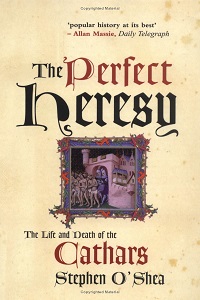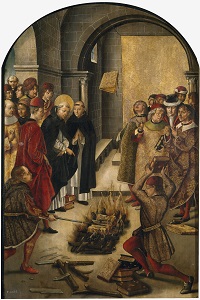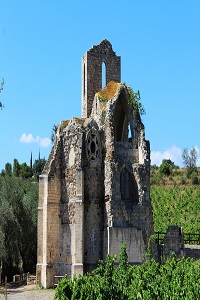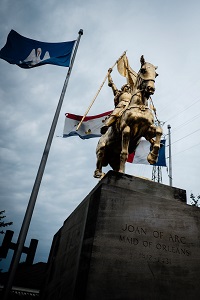How will these resources help you?
This list focuses on a fascinating era of the history of Christianity in the Languedoc region of medieval France. This interpretation of Christianity – known today as Catharism – was termed the 'Albigensian Heresy' by the Church, and 'Good Christians' by the adherents themselves. The movement was seen as such a threat that it was the focus of crusades and Inquisitions against it and was brutally eradicated. These resources encourage discussions of how a heresy is defined and which powers and groups are the gatekeepers of the 'correct' interpretation of a religion. (Some sections of the material may be more appropriate for older students due to the brutal nature of the campaigns against the Cathars).
The Cathar 'heresy'

The Perfect Heresy: The Life and Death of the Cathars
by Stephen O’Shea, published by Profile Books, (2001), 9781861973504
This readable and comprehensive introduction to the Cathar 'heresy' will enable teachers and students alike to gain an understanding of this pivotal historical moment in the history of religions. In one of the crusades against the Cathars the town of Beziers was targeted as it was sympathetic towards the Cathar worldview. When soldiers asked their leader, the abbot Arnaud Almaury, who they should target, it is reported that he said, 'Kill them all, for God will know His own,' and all 20,000 inhabitants were murdered. On the religious and philosophical beliefs of the Cathars, the author emphasises the roles that dualism, reincarnation and gender equality may have played in causing such a brutal response, and addresses misconceptions held about the Cathars as well as the reasons for their demise.
Catharism: Podcast

In Our Time: Catharism
by Melvyn Bragg, published by BBC Radio 4, (2002)
This podcast episode unpacks many of the key theological ideas within Catharism that posed such a great challenge to the dominant Catholic faith. The Cathar dualistic worldview, and how this contradicted the aims of the Catholic Popes at the time, is addressed at length. This view rendered the physical sacraments of the Church baseless for salvation and questioned the very authority of the Church. The episode explores how Saints such as St Francis and St Domonique were like the Cathars in encouraging tolerance, poverty and a rejection of worldly matters, but that as they did not openly challenge the Catholic Church’s structures they were welcomed into the faith. The appeal of the Cathar faith and its enduring philosophical insights into the nature of the universe and nature of the evil found within it is explored, and will be of particular interest to A-level students who will see overlaps with the philosophy of religion and the nature of God.

Catharism in literature
by Kate Mosse, published by Orion, (2006), 9780752877327
The best-known set of novels on the Cathar faith is the Languedoc Trilogy. It follows two women in the same geographical location, separated by hundreds of years. The story of a modern-day archaeologist is intertwined with the perspective of, a 13th-century Cathar during the crusades against her faith. The first of these novels, Labyrinth, tells the tale of the horrific siege and massacre of hundreds at Montsegur. Sections of the novel could be used in the classroom to explore the motivations and experiences of people who remain committed to a faith despite the risk to their lives and communities.
Catharism in the modern day

The Cathars and Their Modern Day Revival
by Andrew Phillip Smith, published by New Dawn Magazine, Vol. 10, No. 2, (2016)
Although the Cathar movement was eradicated through the actions of crusades and Inquisitions, there are still small groups of people today who adhere to its worldview and seek to live by its principles and teachings. This article from an esoteric magazine outlines the key teachings and history of the group and also how 19th-century explorers such as Otto Rahn (dubbed the 'real-life Indiana Jones') found fascination with the religion and helped to spur a minor renaissance of the faith. The article could be used as a basis for discussion in the classroom, to explore the appeal of ideas from the past, and as an example of how religions and worldviews evolve to suit new settings.
Audiovisual clip

Chivalry and Betrayal: The Hundred Years War - The trial and execution of Joan of Arc
published by BBC Four, (2013)
A clip explaining why Joan of Arc was accused of being a heretic, and put on trial for being a witch. Not only was this a religious trial launched against Joan of Arc, but also against Charles the 7th, accused of becoming King not through God, but through intervention of the devil.
Further materials
The Lost Teachings of the Cathars: Their Beliefs and Practices by Andrew Phillip Smith, published by Duncan Baird Publishers, (2015), 9781780287157
Read this book
Who were the Cathars?, published by Let’s Talk Religion, (2021)
Watch this video
France's Cathar region: Relics of the Middle Ages in the Pyrenees, published by France 24, (2017)
Watch this video
Ruth Marx teaches Religion and Worldviews, is a Consultant for Religious Studies and PSHE, a Farmington Fellowship Scholar and a published blogger on Re:Online.
Text © Ruth Marx, 2023.
Text © Ruth Marx, 2023.



